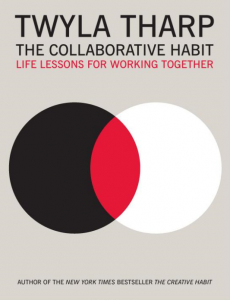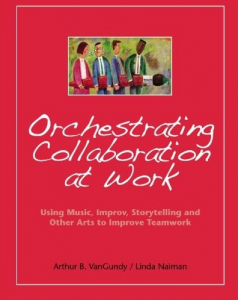 I recently finished a couple of excellent books about workplace collaboration, authored by people immersed in creativity and the arts. Amen! I found these two books complement each other nicely.
I recently finished a couple of excellent books about workplace collaboration, authored by people immersed in creativity and the arts. Amen! I found these two books complement each other nicely.
The Collaborative Habit
The first book is The Collaborative Habit: Life Lessons for Working Together. It’s written by Twyla Tharp, a leading and innovative American dance choreographer, since the 1960s!
In addition to offering insight into what makes for a good collaboration there is a certain wow factor to the book. Tharp has collaborated with numerous well-known personalities in the arts communities; e.g., Jerome Robbins (film director West Side Story), Gregory Hines (dancer), musicians Bob Dylan, Billy Joel, and Elvis Costello, and she openly shares her experiences. Her collaboration with Costello (who scored the music for one of her recent productions) was particularly insightful.
Tharp defines collaboration as people working together sometimes by choice, sometimes not. When something goes wrong, bring in the collaborator someone who works with others to solve a problem.
Here’s a few of the nuggets of advice Tharp explores in her book:
- Collaboration begins as a point of view.
- Before you begin any collaboration, you must ask: am I up to this? Do I have the physical stamina, the core strength?
- If you want a successful first meeting, preparation pays. Get everything on your side before you say hello.
- You’ll get people on board when you ask them what they love.
- The sooner you establish a routine, the more smoothly your collaboration will advance.
- You need a challenging partner. In a good collaboration, differences between partners mean that one plus one will always equal more than two.
- A great partnership is a lab where change happens every day.
- Creativity is heavy lifting it’s a grimy job.
- Collaborative projects offer tutorials in reality. And that tutorial always presents the unexpected.
- Don’t get involved with your collaborator’s problems.
- Collaboration can be internal an act of listening to others and then having a silent, private conversation with yourself.
- A collaboration may not be what it appears (chance, uncredited collaborators are often key to success…)
- The more you ask, the more you get back. The more you challenge an audience, the more challenging you can be to yourself.
- The ultimate best result of any collaboration is learning to look through your collaborator’s eye.
- In the end, all collaborations are love stories.
Orchestrating Collaboration at Work
The second book is Orchestrating Collaboration at Work, originally published in 2003 by Linda Naiman and Arthur VanGundy (now deceased).
Naiman is a Vancouver-based business coach, instructor, blogger, artist, and pioneer in arts-based learning.
If you’re a facilitator and/or sometime looking for some creative exercises to ramp up your organization’s collaboration quotient, this book will interest you.
Naiman’s book is a collection of 70 exercises to spark creativity and collaboration. The exercises were provided by 40 different people. A large number were designed by Naiman herself. Most of the exercises are oriented to small groups; e.g., actual work teams.
The exercises make use of a range of art forms: dance, collage, mixed media, improvisation, theatre, drawing, music, painting, poetry, storytelling, abstraction, graphic design… Using a wide range of disciplines in the arts can help people see their problems and opportunities differently, and tap into their human potential, which every organization is founded on.
Each exercise is described in terms of: objectives, uses (applications in an organization), art form, time required (most are 1-2 hours), materials, handouts, equipment, procedure (steps), and post-exercise discussion guidelines.
Objectives include: improving intra-group communication, developing symbolic metaphoric expression, and fostering creative responses under pressure. Uses include: warm-up for brainstorming sessions, fast thinking, and community building.
I wish I’d come across this book a couple of decades ago! I’ve done lots of facilitation over the years, and even though I have artistic leanings and even a few tendencies, I hardly every used creative facilitation as espoused in this book.
Sure, many of the exercises in this book would take us out of our current comfort zone, yet they speak to something most of us lose as we age openness to new things, willingness to work with different media
I never thought of using poetry, a limerick your learning exercise, where participants, working in groups of 3-5 people, develop limericks as a way to promote team collaboration, and to help people anchor what they learned.
Piecing together a collage, creating stories together this book presents many wonderful exercises that are now on my radar!
Bring on the arts
Gregory Bateson, a seminal thinker in psychiatry, anthropology, and systems theory said that if you juxtapose two forms of description, such as art and science or art and business, that double description, affords you an unexpected bonus of insight akin to the perception of depth in binocular vision a surprise effect not predictable from working with either of the descriptions alone. We all know that when we focus on something with just one eye, we merely a monocular view. We are unable to perceive depth. Depth appears when use both our eyes at once. (quoting John Comino in Orchestrating Collaboration at Work).
What’s your favourite creative method or exercise for getting people to work better together, to collaborating?
If you enjoyed this post, please consider leaving a comment or subscribing to my blog. Thanks, Ben.


Ben, thanks so much for these reviews, I will order and read both books – and am borrowing the excerpt (with credit!) for a MBA course I am teaching next week on managing innovation and productivity in teams; based on my work with Lynda Gratton and Hot Spots. However we approach it keeping that as Lynda calls it Hot Spots sparked by igniting, collaborative mindset and boundary spanning alive in a team is so key; and certainly the arts are a wonderful way, and also a great way to “re-ignite” when the “big freeze” sets in. Many thanks
And, to answer the question, recently I saw some what I consider brilliant work by Ole Qvist-Sørensen of http://www.biggerpicture.dk; at Copenhagen Climate change conference – Ole and his team used dialogue work sheets with some graphics, like footsteps to engage people to draw their thoughts, he also had icons for the delegates to represent concepts so they didn’t have to struggle with the drawint part. His website now has a wonderful interactive way of engaging visitors by drawing out their business problems take a look. Wonderful work grounded in systems and dialogue.
Marilyn, thanks for the comments. Interesting you mention Ole. A couple of months ago I came across his work (via Chris Corrigan, an Open Space facilitator on the west coast of Canada) and some videos Ole had posted on YouTube that help you visualize/draw just about anything. He is amazing. And, the process used at Copenhagen is an interesting example – thanks. Glad to hear the books are giving you some more ideas for your teachings. Lynda Gratton’s work sounds interesting too – I’ll have to check her site out. Cheers, Ben.
Ben,
I, too, have enjoyed both books. There are some simple, everyday ways we can communicate to collaborate such as a “You” – “Us” – “Me” approach in conversation.
At the heart of satisfying and successful collaboration is recognition of the sweet spot of mutual benefit methinks and the most unexpectedly sweet spots are those sighted by extremely disparate people who become partners, allies even sometimes friends as they bring out the better side in each other as they pursue that common purpose.
If more people sought that sweet spot of mutual benefit sooner we might have deeper, more diverse ties in our worlds, globally and locally – in work, community and personal life.
Wed avoid the horrific downside cited in two books, The Big Sort and Going to Extremes.
That’s the trend in which like-minded people increasingly hang out together in the U.S. The counter-intuitive way we seek “belonging” in such groups is by taking an extreme stand, ostensibly exemplifying the core belief of “my” group, thus making the group more extreme in its beliefs over time.
There are some simply powerful ways we can connect and collaborate that I cover in Moving From Me to We.
Thanks for your input Kare. I think you’re right on the potential benefits of diverse groups, of bringing disparate people together. Years ago I lived in Toronto, Ontario and remember how the city’s mayor at the time, who was very “progressive”, took it upon himself to take big bank executives on a walking tour of the city – introducing them to the disparate, and sometimes destitute, range of people who lived there. It was all in the spirit of we can’t hate someone whose story we know. Perhaps this is what Obama was thinking of when he recently met with the Republican caucus! I like your blog – it’s touching on all of these things…
Interesting blog. Thanks for making my day.
Ben
I thoroughly enjoyed your post that cited that mayor’s walkabouts. I have a client who is an advocate for bees (DisneyNature comes out with a film on that topic next year) so your inclusion in that post of the org. that works with recently released prisoners resonated with me as an avid fan of Delancey St. here in S.F. – your ideas are so life-affirming and practical
Thanks Kare. Glad you enjoyed the BP post, and I really value your thoughts. I’ll keep my eyes open for the DisneyNature film – the whole beekeeping model they’re using in Chicago seems so systems-like; e.g., it addresses people relationship issues, contributes to employment, incorporates natural elements/processes… makes me wonder why we don’t do more of that type of thing.